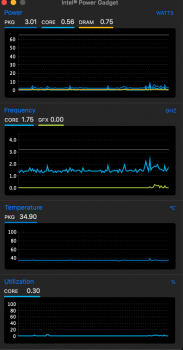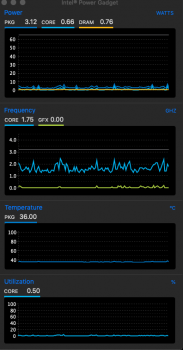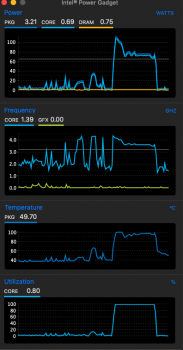I really don't know what we are arguing about. The graphs clearly show that full max core boosts make it hit >110 Watts. And that the current cooling system is good only to reach equilibrium at 75 Watts. Which is the heat generated by 6-cores @ 3.6 Ghz.
The fact that this is above the base clock of 3.2 Ghz isn't relevant to anything. The CPU design itself is actually limited to 6-cores @ 4.3 Ghz.
The 'base' clock speed looks to be just defined by the maximum 6-core speed that hits the stated TDP of 65 Watts (or lower).
i.e. The i7-8700B processor has a 6-core speed of 6x3.2 Ghz @ 65 Watts (or lower).
The tests show it also has a 6-core speed of 6x3.6 Ghz @ 75 Watts (the apparent stable limit of the cooling system)
And 6-core speed of 4.3Ghz @ 120 Watts (well above the stable limit of the cooling system).
The same processor could have been marketed as a 35 W processor with base clock of 2.3 Ghz. Obviously with a cooling system fit for only 35 Watts, the max all-core turbo is now going to be ~2.3 Ghz. And no one would say it is throttling...Even though the CPU would be identical...and it is clearly being throttled relative to the performance it could get with better cooling.
[doublepost=1542398185][/doublepost]
I really don't know what we are arguing about. The graphs clearly show that full max core boosts make it hit >110 Watts. And that the current cooling system is good only to reach equilibrium at 75 Watts. Which is the heat generated by 6-cores @ 3.6 Ghz.
The fact that this is above the base clock of 3.2 Ghz isn't relevant to anything. The CPU design itself is actually limited to 6-cores @ 4.3 Ghz.
The 'base' clock speed looks to be just defined by the maximum 6-core speed that hits the stated TDP of 65 Watts (or lower).
i.e. The i7-8700B processor has a 6-core speed of 6x3.2 Ghz @ 65 Watts (or lower).
The tests show it also has a 6-core speed of 6x3.6 Ghz @ 75 Watts (the apparent stable limit of the cooling system)
And 6-core speed of 4.3Ghz @ 120 Watts (well above the stable limit of the cooling system).
The same processor could have been marketed as a 35 W processor with base clock of 2.3 Ghz. Obviously with a cooling system fit for only 35 Watts, the max all-core turbo is now going to be ~2.3 Ghz. And no one would say it is throttling...Even though the CPU would be identical...and it is clearly being throttled relative to the performance it could get with better cooling.
Take the new MBAir processor - 1.6 GHz base and 3.6 Ghz turbo. A 7 Watt chip.
I expect that 7 watts is probably the power draw of the dual-core chip at 1.6 Ghz base speed.
There is no way it is using 7 Watts at 3.6Ghz.
Therefore, to get faster speeds for any length of time, you needs a cooling system much better than 7 Watts.
But let's say the sustained dual core speed in the MBAir is only 2 Ghz...would we not conclude that it is significantly throttled?
[doublepost=1542398245][/doublepost]Anyway...this is getting tiresome...




